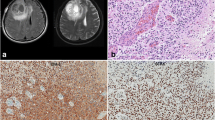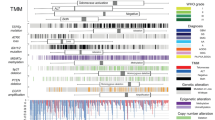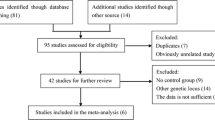Abstract
Purpose of Review
High-throughput genomic sequencing has identified alterations in the gene encoding human telomerase reverse transcriptase (TERT) as points of interest for elucidating the oncogenic mechanism of multiple different cancer types, including gliomas. In gliomas, the TERT promoter mutation (TPM) and resultant overexpression of TERT are observed mainly in the most aggressive (primary glioblastoma/grade IV astrocytoma) and the least aggressive (grade II oligodendroglioma) cases. This article reviews recent research on (1) the mechanism of TERT activation in glioma, (2) downstream consequences of TERT overexpression on glioma pathogenesis, and (3) targeting TPMs as a therapeutic strategy.
Recent Findings
New molecular classifications for gliomas include using TPMs, where the mutant group demonstrates the worst prognosis. Though a canonical function of TERT is established in regard to telomere maintenance, recent studies on non-canonical functions of TERT explore varied roles of telomerase in tumor progression and maintenance.
Summary
Somatic alterations of the TERT promoter present a promising target for novel therapeutics development in primary glioma treatment.

Similar content being viewed by others
References
Papers of particular interest, published recently, have been highlighted as: • Of importance •• Of major importance
Ostrom Q, Gittleman H, Farah P, Ondracek A, Chen Y, Wolinsky Y, et al. CBTRUS statistical report: primary brain and central nervous system tumors diagnosed in the United States in 2006–2010. Neuro-Oncology. 2013;15(Suppl 2):56–ii56. https://doi.org/10.1093/neuonc/not151.
Norden AD, Drappatz J, Wen PY. Antiangiogenic therapies for high-grade glioma. Nat Rev Neurol. 2009;5(11):610–20. https://doi.org/10.1038/nrneurol.2009.159.
Claes A, Idema A, Wesseling P. Diffuse glioma growth: a guerilla war. Acta Neuropathol. 2007;114(5):443–58. https://doi.org/10.1007/s00401-007-0293-7.
Brennan CW, Verhaak RG, McKenna A, Campos B, Noushmehr H, Salama SR, et al. The somatic genomic landscape of glioblastoma. Cell. 2013;155(2):462–77. https://doi.org/10.1016/j.cell.2013.09.034.
Killela PJ, Reitman ZJ, Jiao Y, Bettegowda C, Agrawal N, Diaz LA, et al. TERT promoter mutations occur frequently in gliomas and a subset of tumors derived from cells with low rates of self-renewal. Proc Natl Acad Sci U S A. 2013;110:6021–6. https://doi.org/10.1073/pnas.1303607110.
Vinagre J, Almeida A, Populo H, Batista R, Lyra J, Pinto V, et al. Frequency of TERT promoter mutations in human cancers. Nat Commun. 2013;4:2185. https://doi.org/10.1038/ncomms3185.
Barthel FP, Wei W, Tang M, Martinez-Ledesma E, Hu X, Amin SB, et al. Systematic analysis of telomere length and somatic alterations in 31 cancer types. Nat Genet. 2017;49:349–57. https://doi.org/10.1038/ng.3781.
Lee J, Solomon DA, Tihan T. The role of histone modifications and telomere alterations in the pathogenesis of diffuse gliomas in adults and children. J Neuro-Oncol. 2017;132(1):1–11. https://doi.org/10.1007/s11060-016-2349-9.
Blackburn EH. Telomerase and cancer: Kirk A. Landon—AACR prize for basic cancer research lecture. Mol Cancer Res: MCR. 2005;3(9):477–82. https://doi.org/10.1158/1541-7786.MCR-05-0147.
• Ceccarelli M, Barthel FP, Malta TM, Sabedot TS, Salama SR, Murray BA, et al. Molecular profiling reveals biologically discrete subsets and pathways of progression in diffuse glioma. Cell. 2016;164(3):550–63. https://doi.org/10.1016/j.cell.2015.12.028. The authors molecularly profiled 1122 gliomas to provide a comprehensive report on improved disease classification and molecular correlations. They also reported telomere lengths and TERT expression between TERT promoter mutant and ATRX mutant cases.
•• Bell RJ, Rube HT, Kreig A, Mancini A, Fouse SD, Nagarajan RP, et al. Cancer. The transcription factor GABP selectively binds and activates the mutant TERT promoter in cancer. Science. 2015;348(6238):1036–9. https://doi.org/10.1126/science.aab0015. The two most common TERT promoter mutations result in a sequence recognized by the transcription factor, GABP. This study provided the first evidence towards a mechanism for TERT reactivation, dependent on promoter mutations.
Balasubramanian S, Hurley LH, Neidle S. Targeting G-quadruplexes in gene promoters: a novel anticancer strategy? Nat Rev Drug Discov. 2011;10(4):261–75. https://doi.org/10.1038/nrd3428.
Akincilar SC, Khattar E, Boon PL, Unal B, Fullwood MJ, Tergaonkar V. Long-range chromatin interactions drive mutant TERT promoter activation. Cancer Discov. 2016;6(11):1276–91. https://doi.org/10.1158/2159-8290.CD-16-0177.
• Stern JL, Theodorescu D, Vogelstein B, Papadopoulos N, Cech TR. Mutation of the TERT promoter, switch to active chromatin, and monoallelic TERT expression in multiple cancers. Genes Dev. 2015;29:2219–24. https://doi.org/10.1101/gad.269498.115. The authors describe chromatin state changes and recruitment of GABP to the TERT promoter mutation across multiple cancer cell lines.
Li Y, Zhou QL, Sun W, Chandrasekharan P, Cheng HS, Ying Z, et al. Non-canonical NF-kappaB signalling and ETS1/2 cooperatively drive C250T mutant TERT promoter activation. Nat Cell Biol. 2015;17(10):1327–38. https://doi.org/10.1038/ncb3240.
Greider CW, Blackburn EH. Identification of a specific telomere terminal transferase activity in Tetrahymena extracts. Cell. 1985;43(2 Pt 1):405–13.
Campisi J, Kim SH, Lim CS, Rubio M. Cellular senescence, cancer and aging: the telomere connection. Exp Gerontol. 2001;36(10):1619–37.
•• Chiba K, Lorbeer FK, Shain AH, McSwiggen DT, Schruf E, Oh A, et al. Mutations in the promoter of the telomerase gene TERT contribute to tumorigenesis by a two-step mechanism. Science. 2017;357:1416–20. https://doi.org/10.1126/science.aao0535. The authors report a mechanism by which cells with TERT promoter mutations can, paradoxically, have short telomeres.
Fallet E, Jolivet P, Soudet J, Lisby M, Gilson E, Teixeira MT. Length-dependent processing of telomeres in the absence of telomerase. Nucleic Acids Res. 2014;42(6):3648–65. https://doi.org/10.1093/nar/gkt1328.
Li JS, Miralles Fuste J, Simavorian T, Bartocci C, Tsai J, Karlseder J et al. TZAP: a telomere-associated protein involved in telomere length control. Science 2017;355(6325):638-41. https://doi.org/10.1126/science.aah6752.
Ahmad F, Patrick S, Sheikh T, Sharma V, Pathak P, Malgulwar PB, et al. TERT-EZH2 network regulates lipid metabolism and DNA damage responses in glioblastoma. J Neurochem. 2017;143:671–83. https://doi.org/10.1111/jnc.14152.
Strickland M, Stoll EA. Metabolic reprogramming in glioma. Front. Cell Dev. Biol. 2017;5:43. https://doi.org/10.3389/fcell.2017.00043.
Barthel F, Wesseling P, Verhaak R. Reconstructing the molecular life history of gliomas. bioRxiv. 2017. https://doi.org/10.1101/192369.
Cong Y, Shay JW. Actions of human telomerase beyond telomeres. Cell Res. 2008;18:725–32. https://doi.org/10.1038/cr.2008.74.
Jakob S, Schroeder P, Lukosz M, Buchner N, Spyridopoulos I, Altschmied J, et al. Nuclear protein tyrosine phosphatase Shp-2 is one important negative regulator of nuclear export of telomerase reverse transcriptase. J Biol Chem. 2008;283(48):33155–61. https://doi.org/10.1074/jbc.M805138200.
•• Maida Y, Yasukawa M, Furuuchi M, Lassmann T, Possemato R, Okamoto N, et al. An RNA-dependent RNA polymerase formed by TERT and the RMRP RNA. Nature. 2009;461(7261):230–5. https://doi.org/10.1038/nature08283. This study describes a non-canonical function of TERT in mitochondria, where it acts as an RNA-dependent RNA polymerase (RdRP) (see reference citation [63] for clinical trial study design of targeting RdRP function in glioblastoma).
Sulkowski PL, Corso CD, Robinson ND, Scanlon SE, Purshouse KR, Bai H, et al. 2-Hydroxyglutarate produced by neomorphic IDH mutations suppresses homologous recombination and induces PARP inhibitor sensitivity. Sci Transl Med. 2017;9(375):eaal2463. https://doi.org/10.1126/scitranslmed.aal2463.
Low KC, Tergaonkar V. Telomerase: central regulator of all of the hallmarks of cancer. Trends Biochem Sci. 2013;38:426–34. https://doi.org/10.1016/j.tibs.2013.07.001.
Herms JW, von Loewenich FD, Behnke J, Markakis E, Kretzschmar HA. c-myc oncogene family expression in glioblastoma and survival. Surg Neurol. 1999;51(5):536–42.
Koh CM, Khattar E, Leow SC, Liu CY, Muller J, Ang WX, et al. Telomerase regulates MYC-driven oncogenesis independent of its reverse transcriptase activity. J Clin Invest. 2015;125(5):2109–22. https://doi.org/10.1172/JCI79134.
Park JI, Venteicher AS, Hong JY, Choi J, Jun S, Shkreli M, et al. Telomerase modulates Wnt signalling by association with target gene chromatin. Nature. 2009;460(7251):66–72. https://doi.org/10.1038/nature08137.
Listerman I, Gazzaniga FS, Blackburn EH. An investigation of the effects of the core protein telomerase reverse transcriptase on Wnt signaling in breast cancer cells. Mol Cell Biol. 2014;34(2):280–9. https://doi.org/10.1128/MCB.00844-13.
Hu B, Wang Q, Wang YA, Hua S, Sauv CEG, Ong D, et al. Epigenetic activation of WNT5A drives glioblastoma stem cell differentiation and invasive growth. Cell. 2016;167:1281–1295.e18. https://doi.org/10.1016/j.cell.2016.10.039.
Lee Y, Lee JK, Ahn SH, Lee J, Nam DH. WNT signaling in glioblastoma and therapeutic opportunities. Lab Invest. 2016;96(2):137–50. https://doi.org/10.1038/labinvest.2015.140.
Martinez P, Blasco MA. Telomeric and extra-telomeric roles for telomerase and the telomere-binding proteins. Nat Rev Cancer. 2011;11(3):161–76. https://doi.org/10.1038/nrc3025.
Haendeler J, Drose S, Buchner N, Jakob S, Altschmied J, Goy C, et al. Mitochondrial telomerase reverse transcriptase binds to and protects mitochondrial DNA and function from damage. Arterioscler Thromb Vasc Biol. 2009;29(6):929–35. https://doi.org/10.1161/ATVBAHA.109.185546.
Khattar E, Kumar P, Liu CY, Akincilar SC, Raju A, Lakshmanan M, et al. Telomerase reverse transcriptase promotes cancer cell proliferation by augmenting tRNA expression. J Clin Invest. 2016;126(10):4045–60. https://doi.org/10.1172/JCI86042.
Li Y, Cheng HS, Chng WJ, Tergaonkar V. Activation of mutant TERT promoter by RAS-ERK signaling is a key step in malignant progression of BRAF-mutant human melanomas. Proc Natl Acad Sci U S A. 2016;113(50):14402–7. https://doi.org/10.1073/pnas.1611106113.
Vallarelli AF, Rachakonda PS, Andre J, Heidenreich B, Riffaud L, Bensussan A, et al. TERT promoter mutations in melanoma render TERT expression dependent on MAPK pathway activation. Oncotarget. 2016;7(33):53127–36. https://doi.org/10.18632/oncotarget.10634.
Matsumura N, Nakajima N, Yamazaki T, Nagano T, Kagoshima K, Nobusawa S, et al. Concurrent TERT promoter and BRAF V600E mutation in epithelioid glioblastoma and concomitant low-grade astrocytoma. Neuropathology. 2017;37(1):58–63. https://doi.org/10.1111/neup.12318.
Batista R, Cruvinel-Carloni A, Vinagre J, Peixoto J, Catarino TA, Campanella NC, et al. The prognostic impact of TERT promoter mutations in glioblastomas is modified by the rs2853669 single nucleotide polymorphism. Int J Cancer. 2016;139(2):414–23. https://doi.org/10.1002/ijc.30057.
Beck S, Jin X, Sohn YW, Kim JK, Kim SH, Yin J, et al. Telomerase activity-independent function of TERT allows glioma cells to attain cancer stem cell characteristics by inducing EGFR expression. Molecules Cells. 2011;31(1):9–15. https://doi.org/10.1007/s10059-011-0008-8.
Spiegl-Kreinecker S, Lotsch D, Ghanim B, Pirker C, Mohr T, Laaber M, et al. Prognostic quality of activating TERT promoter mutations in glioblastoma: interaction with the rs2853669 polymorphism and patient age at diagnosis. Neuro-Oncology. 2015;17(9):1231–40. https://doi.org/10.1093/neuonc/nov010.
Simon M, Hosen I, Gousias K, Rachakonda S, Heidenreich B, Gessi M, et al. TERT promoter mutations: a novel independent prognostic factor in primary glioblastomas. Neuro-Oncology. 2015;17(1):45–52. https://doi.org/10.1093/neuonc/nou158.
Mosrati MA, Malmstrom A, Lysiak M, Krysztofiak A, Hallbeck M, Milos P, et al. TERT promoter mutations and polymorphisms as prognostic factors in primary glioblastoma. Oncotarget. 2015;6(18):16663–73. https://doi.org/10.18632/oncotarget.4389.
Gao K, Li G, Qu Y, Wang M, Cui B, Ji M, et al. TERT promoter mutations and long telomere length predict poor survival and radiotherapy resistance in gliomas. Oncotarget. 2016;7:8712–25. https://doi.org/10.18632/oncotarget.6007.
Fan X, Wang Y, Liu Y, Liu X, Zhang C, Wang L, et al. Brain regions associated with telomerase reverse transcriptase promoter mutations in primary glioblastomas. J Neuro-Oncol. 2016;128:455–62. https://doi.org/10.1007/s11060-016-2132-y.
Ersoy TF, Keil VC, Hadizadeh DR, Gielen GH, Fimmers R, Waha A, et al. New prognostic factor telomerase reverse transcriptase promotor mutation presents without MR imaging biomarkers in primary glioblastoma. Neuroradiology. 2017;59(12):1223–31. https://doi.org/10.1007/s00234-017-1920-1.
Arita H, Yamasaki K, Matsushita Y, Nakamura T, Shimokawa A, Takami H, et al. A combination of TERT promoter mutation and MGMT methylation status predicts clinically relevant subgroups of newly diagnosed glioblastomas. Acta Neuropathol Commun. 2016;4(1):79. https://doi.org/10.1186/s40478-016-0351-2.
Nguyen HN, Lie A, Li T, Chowdhury R, Liu F, Ozer B, et al. Human TERT promoter mutation enables survival advantage from MGMT promoter methylation in IDH1 wild-type primary glioblastoma treated by standard chemoradiotherapy. Neuro-Oncology. 2017;19(3):394–404. https://doi.org/10.1093/neuonc/now189.
Labussiere M, Boisselier B, Mokhtari K, Di Stefano AL, Rahimian A, Rossetto M, et al. Combined analysis of TERT, EGFR, and IDH status defines distinct prognostic glioblastoma classes. Neurology. 2014;83(13):1200–6. https://doi.org/10.1212/WNL.0000000000000814.
Verhaak RG, Hoadley KA, Purdom E, Wang V, Qi Y, Wilkerson MD, et al. Integrated genomic analysis identifies clinically relevant subtypes of glioblastoma characterized by abnormalities in PDGFRA, IDH1, EGFR, and NF1. Cancer Cell. 2010;17(1):98–110. https://doi.org/10.1016/j.ccr.2009.12.020.
Baerlocher G, Vulto I, de Jong G, Lansdorp P. Flow cytometry and FISH to measure the average length of telomeres (flow FISH). Nat Protoc. 2006;1:2365–76. https://doi.org/10.1038/nprot.2006.263.
Gunkel M, Chung I, Worz S, Deeg KI, Simon R, Sauter G, et al. Quantification of telomere features in tumor tissue sections by an automated 3D imaging-based workflow. Methods. 2017;114:60–73. https://doi.org/10.1016/j.ymeth.2016.09.014.
O'callaghan NJ, Fenech M. A quantitative PCR method for measuring absolute telomere length. Biological procedures Online. 2011;13:3. https://doi.org/10.1186/1480-9222-13-3.
Feuerbach L, Sieverling L, Deeg K, Ginsbach P, Hutter B, Buchhalter I et al. TelomereHunter: telomere content estimation and characterization from whole genome sequencing data 2016. bioRxiv. https://doi.org/10.1101/065532.
Ding Z, Mangino M, Aviv A, Spector T, Durbin R. Estimating telomere length from whole genome sequence data. Nucleic Acids Res. 2014;42:e75. https://doi.org/10.1093/nar/gku181.
Chen Y, Wu Y, Huang X, Qu P, Li G, Jin T, et al. Leukocyte telomere length: a novel biomarker to predict the prognosis of glioma patients. J Cancer Res Clin Oncol. 2015;141(10):1739–47. https://doi.org/10.1007/s00432-015-1938-x.
• Goldvaser H, Gutkin A, Beery E, Edel Y, Nordenberg J, Wolach O, et al. Characterisation of blood-derived exosomal hTERT mRNA secretion in cancer patients: a potential pan-cancer marker. Br J Cancer. 2017;117:353–7. https://doi.org/10.1038/bjc.2017.166. This study presents the measurement and use of exosomal mRNA to detect TERT transcripts across multiple cancers.
Miyazaki T, Pan Y, Joshi K, Purohit D, Hu B, Demir H, et al. Telomestatin impairs glioma stem cell survival and growth through the disruption of telomeric G-quadruplex and inhibition of the proto-oncogene, c-Myb. Clin Cancer Res. 2012;18(5):1268–80. https://doi.org/10.1158/1078-0432.CCR-11-1795.
Shin-ya K, Wierzba K, Matsuo K, Ohtani T, Yamada Y, Furihata K, et al. Telomestatin, a novel telomerase inhibitor from Streptomyces anulatus. J Am Chem Soc. 2001;123(6):1262–3.
Nakamura T, Okabe S, Yoshida H, Iida K, Ma Y, Sasaki S, et al. Targeting glioma stem cells in vivo by a G-quadruplex-stabilizing synthetic macrocyclic hexaoxazole. Sci Rep. 2017;7(1):3605. https://doi.org/10.1038/s41598-017-03785-8.
Marian CO, Cho SK, McEllin BM, Maher EA, Hatanpaa KJ, Madden CJ, et al. The telomerase antagonist, imetelstat, efficiently targets glioblastoma tumor-initiating cells leading to decreased proliferation and tumor growth. Clin Cancer Res. 2010;16(1):154–63. https://doi.org/10.1158/1078-0432.CCR-09-2850.
Takahashi M, Miki S, Fukuoka K, Maida Y, Hayashi M, Hamada A, et al. EXTH-50. Development of investigator initiated clinical trial of TERT-targeting therapy using eribulin mesylate in patients with recurrent glioblastoma. Neuro-oncology. 2017;19(suppl_6):vi83–vi. https://doi.org/10.1093/neuonc/nox168.342.
Hasegawa D, Okabe S, Okamoto K, Nakano I, Shin-ya K, Seimiya H. G-quadruplex ligand-induced DNA damage response coupled with telomere dysfunction and replication stress in glioma stem cells. Biochem Biophys Res Commun. 2016;471(1):75–81. https://doi.org/10.1016/j.bbrc.2016.01.176.
Zhou G, Liu X, Li Y, Xu S, Ma C, Wu X, et al. Telomere targeting with a novel G-quadruplex-interactive ligand BRACO-19 induces T-loop disassembly and telomerase displacement in human glioblastoma cells. Oncotarget. 2016;7(12):14925–39. https://doi.org/10.18632/oncotarget.7483.
• Kang HJ, Cui Y, Yin H, Scheid A, Hendricks WP, Schmidt J, et al. A pharmacological chaperone molecule induces cancer cell death by restoring tertiary DNA structures in mutant hTERT promoters. J Am Chem Soc. 2016;138:13673–92. https://doi.org/10.1021/jacs.6b07598. This study reports the efficacy of a novel small molecule designed to correct the tertiary structure of the TERT promoter region which is lost as a result of TERT promoter mutations.
Bollam SR, Dhruv HD, Kang H-J, Peng S, Gokhale V, Hurley L, et al. Abstract 1169: mtTERT promoter as a target for treatment of glioblastoma. Cancer Res. 2017;77:1169.
Berardinelli F, Siteni S, Tanzarella C, Stevens MF, Sgura A, Antoccia A. The G-quadruplex-stabilising agent RHPS4 induces telomeric dysfunction and enhances radiosensitivity in glioblastoma cells. DNA Repair. 2015;25:104–15. https://doi.org/10.1016/j.dnarep.2014.10.009.
Nemunaitis J, Tong AW, Nemunaitis M, Senzer N, Phadke AP, Bedell C, et al. A phase I study of telomerase-specific replication competent oncolytic adenovirus (telomelysin) for various solid tumors. Mol Ther. 2010;18(2):429–34. https://doi.org/10.1038/mt.2009.262.
Martinez P, Blasco MA. Telomere-driven diseases and telomere-targeting therapies. J Cell Biol. 2017;216(4):875–87. https://doi.org/10.1083/jcb.201610111.
•• Salloum R, Hummel TR, Kumar SS, Dorris K, Li S, Lin T, et al. A molecular biology and phase II study of imetelstat (GRN163L) in children with recurrent or refractory central nervous system malignancies: a pediatric brain tumor consortium study. J Neuro-Oncol. 2016;129:443–51. https://doi.org/10.1007/s11060-016-2189-7. The authors summarize findings from an investigator-sponsored study to determine efficacy of imetelstat (inhibition of telomerase RNA) in pediatric CNS malignancies and show intratumoral reduction of telomerase activity.
Hu Y, Shi G, Zhang L, Li F, Jiang Y, Jiang S, et al. Switch telomerase to ALT mechanism by inducing telomeric DNA damages and dysfunction of ATRX and DAXX. Sci Rep. 2016;6:32280. https://doi.org/10.1038/srep32280.
Acknowledgments
The authors would like to thank The Ben and Catherine Ivy Foundation for their financial support.
Author information
Authors and Affiliations
Corresponding author
Ethics declarations
Conflict of Interest
Saumya R. Bollam, Michael E. Berens, and Harshil D. Dhruv declare no conflict of interest.
Human and Animal Rights and Informed Consent
This article does not contain any studies with human or animal subjects performed by any of the authors.
Additional information
This article is part of the Topical Collection on Neuro-Oncology
Rights and permissions
About this article
Cite this article
Bollam, S.R., Berens, M.E. & Dhruv, H.D. When the Ends Are Really the Beginnings: Targeting Telomerase for Treatment of GBM. Curr Neurol Neurosci Rep 18, 15 (2018). https://doi.org/10.1007/s11910-018-0825-7
Published:
DOI: https://doi.org/10.1007/s11910-018-0825-7




